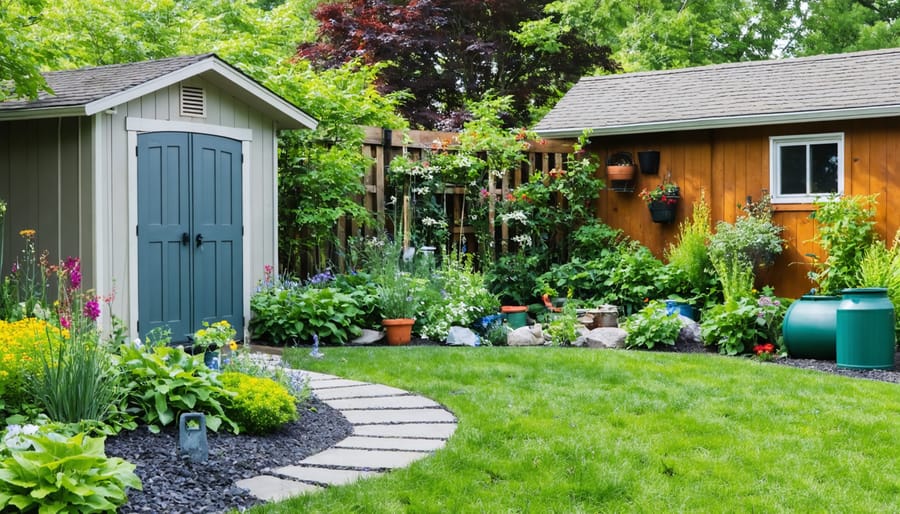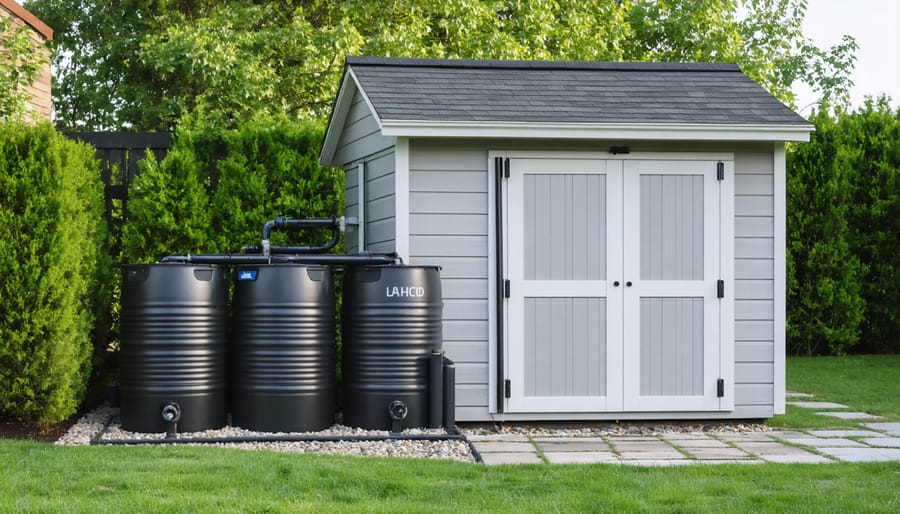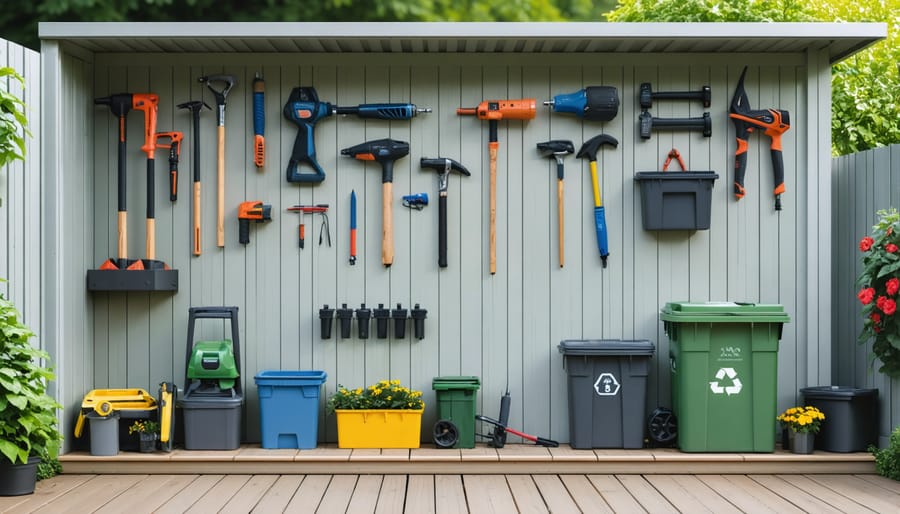Transform Your Yard into an Eco-Paradise (While Saving Time and Money)

Transform your yard into an eco-friendly sanctuary by adopting sustainable maintenance practices that work in harmony with nature. Start by replacing gas-powered equipment with electric or manual alternatives, reducing both emissions and noise pollution while maintaining optimal lawn care. Establish a natural water management system through strategic plant placement, rain gardens, and water-efficient irrigation methods that minimize waste and support local ecosystems. Create dedicated zones in your yard for composting stations and native plant gardens, using your shed as an organized hub for earth-friendly tools and organic fertilizers. These thoughtful approaches not only reduce your environmental impact but also create a thriving, low-maintenance outdoor space that supports local wildlife while cutting down on resource consumption and maintenance costs. By integrating these sustainable practices, your yard becomes more than just a green space – it becomes an active participant in environmental conservation.
Smart Water Management for Your Yard
Rainwater Collection Systems
Installing a rainwater collection system near your shed is an excellent way to conserve water and reduce your utility bills while maintaining a healthy garden. Start by positioning rain barrels at your shed’s downspouts, ensuring they’re elevated on sturdy platforms for better water pressure. A standard 55-gallon barrel can collect about half an inch of rain from a typical shed roof, providing plenty of water for your garden needs.
To maximize efficiency, install a first-flush diverter to filter out debris and initial roof runoff. Connect multiple barrels using overflow pipes to increase your storage capacity during heavy rainfall. Consider adding a small pump or gravity-fed drip irrigation system to make watering easier.
For aesthetic appeal, paint your rain barrels to match your shed or disguise them with climbing plants. Remember to clean your gutters regularly and check screens for debris. During winter, drain and disconnect your barrels to prevent freezing damage. In drought-prone areas, consider installing larger underground cisterns for maximum water storage capacity.
This sustainable approach not only helps the environment but also provides a reliable water source for your garden during dry spells.

Drought-Resistant Landscaping
Transform your shed’s surroundings into a water-wise oasis by selecting drought-resistant plants that thrive with minimal irrigation. Native plants are excellent choices as they’re naturally adapted to your local climate and require less maintenance. Consider incorporating ornamental grasses like fountain grass or blue fescue, which add texture and movement while demanding little water.
Create zones around your shed based on water needs, placing the most drought-tolerant plants furthest from water sources. Succulents and sedums work beautifully along shed edges, providing year-round interest without excessive watering. For ground cover, consider creeping thyme or ice plant, which spread naturally and suppress weed growth.
Enhance water retention by applying a 2-3 inch layer of mulch around your plants. This helps maintain soil moisture, regulate temperature, and reduce weed competition. Consider installing a drip irrigation system for targeted watering when needed, and collect rainwater from your shed’s roof in barrels for natural irrigation during dry spells.
Remember to group plants with similar water requirements together to prevent overwatering some while underwatering others. This smart planning ensures your shed area remains both beautiful and environmentally responsible.
Natural Pest Control Solutions
Companion Planting
Companion planting is a smart, natural approach to pest control that can significantly reduce your need for chemical pesticides. By strategically placing plants that naturally repel pests next to vulnerable species, you create a balanced ecosystem in your yard. For example, planting marigolds around your vegetable garden helps deter harmful nematodes and other garden pests, while attracting beneficial pollinators.
Consider planting aromatic herbs like basil near tomatoes to repel mosquitoes and flies, or surrounding your roses with garlic to prevent aphid infestations. Nasturtiums act as a natural trap crop, drawing aphids away from your primary plants, while lavender helps keep moths and mice at bay. These natural partnerships not only protect your plants but also create beautiful, fragrant garden combinations.
To maximize effectiveness, group plants with similar water and sunlight needs together. This approach not only helps with pest control but also makes maintenance more efficient and reduces water waste. Remember to rotate your companion plants annually to prevent soil depletion and maintain the natural balance of your garden ecosystem.
Beneficial Insects
Creating a thriving ecosystem of beneficial insects in your yard is like having a natural pest control army at your disposal. These helpful creatures not only protect your plants but also contribute to pollination and soil health. To attract these garden allies, consider planting native flowers like marigolds, lavender, and yarrow around your shed and throughout your yard. These plants provide nectar and shelter for beneficial insects like ladybugs, praying mantises, and parasitic wasps.
Create insect-friendly zones by leaving small piles of leaves or twigs in quiet corners of your yard. When you properly store your tools in your shed, dedicate a small space for creating “insect hotels” using natural materials like bamboo stalks and pine cones. These structures provide safe havens for solitary bees and other helpful insects.
Avoid using chemical pesticides, as they can harm both beneficial and harmful insects alike. Instead, let nature maintain its balance. You’ll notice fewer pest problems over time as your beneficial insect population grows and establishes itself in your yard’s ecosystem.

Green Maintenance Equipment
Manual vs. Electric Tools
When it comes to yard maintenance tools, the choice between manual and electric options significantly impacts both the environment and your maintenance routine. Manual tools like push mowers, hand pruners, and rakes offer zero emissions and complete control over your work, making them ideal for smaller yards and precise tasks. They’re also quieter, require minimal maintenance, and can last for decades with proper care.
Electric tools, particularly battery-powered options, provide more power and efficiency for larger spaces or demanding tasks. While they do consume energy, modern cordless tools are becoming increasingly eco-friendly with improved battery technology and energy efficiency. Consider that electric lawn mowers produce about 85% less greenhouse gas emissions compared to gas-powered alternatives.
For optimal eco-friendly yard maintenance, consider a hybrid approach. Use manual tools for detailed work like pruning and weeding, while reserving electric tools for larger tasks like mowing extensive lawns or hedging. When choosing electric tools, opt for those with Energy Star ratings and look for models with recyclable batteries. Remember to properly maintain and store both types of tools in your shed to extend their lifespan, reducing waste and the need for frequent replacements.
Proper Tool Storage
Proper tool storage isn’t just about keeping your shed tidy – it’s a crucial aspect of eco-friendly shed maintenance that extends the life of your gardening equipment. Start by installing wall-mounted racks and pegboards to keep tools off the ground, preventing rust and reducing the need for premature replacements. When you organize your garden tools vertically, you’ll maximize space while making everything easily accessible.
Create designated zones for different tool categories – hand tools, power equipment, and seasonal items. Use moisture-absorbing solutions like silica gel packets near metal tools to prevent corrosion, and install a small solar-powered fan to maintain proper air circulation. Consider adding a simple workbench made from reclaimed wood for maintaining tools and performing quick repairs.
Label everything clearly and implement a “clean before storing” policy to prevent dirt buildup and extend tool life. Store battery-operated tools near an outlet for convenient charging, and keep chemical products in sealed containers on high shelves. Remember to inspect tools regularly for maintenance needs – catching issues early prevents waste and ensures your equipment serves you well for years to come.

Sustainable Yard Waste Management
Composting Basics
Transform your yard waste into garden gold by setting up a compost system near your shed. Choose a partially shaded spot about 5-10 feet from your shed wall to ensure good airflow while keeping tools easily accessible. Start with a simple three-bin system: one for fresh materials, one for actively decomposing matter, and one for finished compost.
Layer your compost with both green materials (grass clippings, kitchen scraps, coffee grounds) and brown materials (dead leaves, twigs, paper) in roughly equal amounts. Keep your compost pile as moist as a wrung-out sponge and turn it every few weeks using a pitchfork stored in your shed.
To maintain optimal decomposition, store a spray bottle of water and a basic compost thermometer in your shed. The pile should feel warm in the center, indicating healthy bacterial activity. Remember to cover your compost during heavy rains to prevent excess moisture, and add brown materials if the pile becomes too wet or starts to smell.
Your finished compost should be dark, crumbly, and smell like fresh earth – perfect for enriching your garden naturally.
Natural Mulching Techniques
Transform your yard waste into a valuable resource by implementing natural mulching techniques. Start by collecting fallen leaves, grass clippings, and small twigs from your yard maintenance routine. These materials can be spread directly around plants and trees, creating a protective layer that helps retain moisture and suppress weed growth.
For best results, layer your natural mulch about 2-3 inches thick, keeping it slightly away from plant stems and tree trunks to prevent rot. Grass clippings make excellent mulch when dried slightly and applied in thin layers, while shredded leaves can be used immediately. As these materials break down, they enrich your soil with essential nutrients, reducing the need for chemical fertilizers.
Consider setting up a dedicated area near your shed for collecting and processing mulch materials. This makes it convenient to store and access your natural mulch throughout the growing season. You can also use a mulching mower to shred leaves and clippings into finer particles, which decompose more quickly and create a neater appearance in your garden beds.
This sustainable approach not only saves money on store-bought mulch but also reduces yard waste while improving soil health naturally.
Embracing eco-friendly yard maintenance practices not only benefits our environment but also creates a healthier, more sustainable outdoor space for your family. By implementing natural pest control methods, using manual or electric tools, and practicing smart water management, you’ll reduce your carbon footprint while maintaining a beautiful yard. These sustainable approaches often lead to cost savings through reduced water usage and elimination of chemical products. Best of all, many of these practices integrate perfectly with your existing shed storage and maintenance routine. Making the switch to eco-friendly yard care doesn’t have to happen all at once – start with one or two methods and gradually expand your green practices. Your yard, local ecosystem, and future generations will thank you for taking these important steps toward environmental stewardship.

